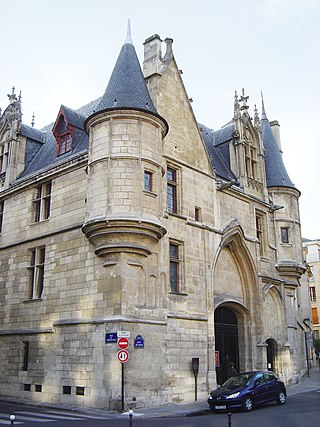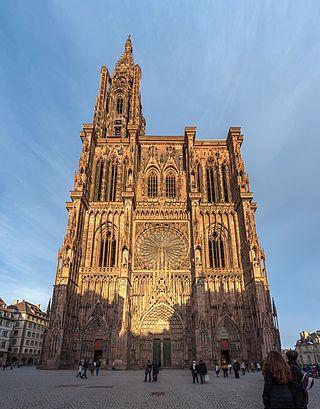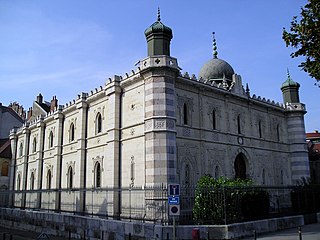
The Marais is a historic district in Paris, France. It spreads across parts of the 3rd and 4th arrondissements on the Rive Droite, or Right Bank, of the Seine. Having once been an aristocratic district, it is home to many buildings of historic and architectural importance. It lost its status as a fashionable district in the late 18th century, with only minor nobles calling the area home. After the French Revolution, the district fell into disrepair and was abandoned by nobility. After a long period of decay, the district has undergone transformation in recent years and is now once again amongst the more fashionable areas of Paris, known for its art galleries, upscale restaurants and museums.

Strasbourg Cathedral or the Cathedral of Our Lady of Strasbourg, also known as Strasbourg Minster, is a Catholic cathedral in Strasbourg, Alsace, France. Although considerable parts of it are still in Romanesque architecture, it is widely considered to be among the finest examples of Rayonnant Gothic architecture. Architect Erwin von Steinbach is credited for major contributions from 1277 to his death in 1318, and beyond through his son Johannes von Steinbach, and his grandson Gerlach von Steinbach, who succeeded him as chief architects. The Steinbachs’ plans for the completion of the cathedral were not followed through by the chief architects who took over after them, and instead of the originally envisioned two spires, a single, octagonal tower with an elongated, octagonal crowning was built on the northern side of the west facade by master Ulrich Ensingen and his successor, Johannes Hültz. The construction of the cathedral, which had started in the year 1015 and had been relaunched in 1190, was finished in 1439.

Rouen Cathedral is a Catholic church in Rouen, Normandy, France. It is the see of the Archbishop of Rouen, Primate of Normandy. It is famous for its three towers, each in a different style. The cathedral, built and rebuilt over a period of more than eight hundred years, has features from Early Gothic to late Flamboyant and Renaissance architecture. It also has a place in art history as the subject of a series of impressionist paintings by Claude Monet.

Bourges Cathedral is a Roman Catholic church located in Bourges, France. The cathedral is dedicated to Saint Stephen and is the seat of the Archbishop of Bourges. Built atop an earlier Romanesque church from 1195 until 1230, it is largely in the Classic Gothic architectural style and was constructed at about the same time as Chartres Cathedral. The cathedral is particularly known for the great size and unity of its interior, the sculptural decoration of its portals, and the large collection of 13th century stained glass windows. Owing to its quintessential Gothic architecture, the cathedral was declared a UNESCO World Heritage Site in 1992.

Troyes Cathedral is a Catholic church, dedicated to Saint Peter and Saint Paul, located in the town of Troyes in Champagne, France. It is the episcopal seat of the Bishop of Troyes. The cathedral, in the Gothic architectural style, has been a listed monument historique since 1862.
David Feuerwerker was a French Jewish rabbi and professor of Jewish history who was effective in the resistance to German occupation the Second World War. He was completely unsuspected until six months before the war ended, when he fled to Switzerland and his wife and baby went underground in France. The French government cited him for his bravery with several awards. After the war, he and his wife re-established the Jewish community of Lyon. He settled in Paris, teaching at the Sorbonne. In 1966, he and his family, grown to six children, moved to Montreal, where he developed a department of Jewish studies at the University of Montreal.

The Musée d'Art et d'Histoire du Judaïsme or mahJ is the largest French museum of Jewish art and history. It is located in the Hôtel de Saint-Aignan in the Marais district in Paris.

The history of the Jews in Alsace is one of the oldest in Europe. It was first attested to in 1165 by Benjamin of Tudela, who wrote about a "large number of learned men" in "Astransbourg"; and it is assumed that it dates back to around the year 1000. Although Jewish life in Alsace was often disrupted by outbreaks of pogroms, at least during the Middle Ages, and reined in by harsh restrictions on business and movement, it has had a continuous existence ever since it was first recorded. At its peak, in 1870, the Jewish community of Alsace numbered 35,000 people.

Saint-Laurent is a Catholic church in the 10th arrondissement of Paris at 68 bis Boulevard de Magenta. A series of churches occupied the site since the 10th century. It is named for Saint Lawrence, an early Christian martyr who was executed in Rome by the Roman Emperor Valerian in 258 AD. It has been listed since 2016 as a monument historique by the French Ministry of Culture.

The Grande synagogue de Lyon is a synagogue located at 13 quai Tilsitt in the 2nd arrondissement of Lyon. This neo-Byzantine Jewish place of worship was built between 1863 and 1864 and renovated for the first time in 2014. It was classified as a monument historique in 1984.

The beginnings of the history of the Jews in Besançon go back to the Middle Ages, a period during which the Jews settled in the city attracted by its activity as a commercial place. The community was founded at the end of the 14th century and, due to its status as a free imperial city, Besançon remained one of the only territories in present-day France to tolerate Jews after their expulsion from the kingdom of France in 1394. The community was nevertheless expelled in turn from Besançon in the middle of the 15th century. The Jews made a tentative return to the city in the 18th century, but it was only after the French Revolution, which emancipated them, that their situation in the Franche-Comté capital stabilized. Although the Jewish community never exceeded 2,000 people except on the eve of the Second World War, it experienced great economic success during the industrial revolution at the end of the 19th century, when the Lipmann family founded LIP, a brand of watchmaking which then became one of the economic engines of the region and remained associated with the name of the city.

The Church of Our Lady of Victories at the Sablon, or the Church of Our Lady of the Sablon, is a Roman Catholic church located in the Sablon/Zavel district, in the historic centre of Brussels, Belgium. It is dedicated to Our Lady of the Sablon.

The Synagogue du Quai Kléber was the main synagogue of Strasbourg, France before World War II. It was built in the "Neustadt" when the city was part of the German Empire and destroyed by Nazi Germany after it annexed the city in 1940; in the years between, Strasbourg and its Jewish community were French.

The synagogue of Lausanne is a synagogue located on Avenue de Florimont in Lausanne, Vaud, Switzerland.

The Saint-Avold Synagogue is a Jewish synagogue at the corner of Rue des Americains and Rue de la Mertzelle near Place Paul-Collin in Saint-Avold, France. The current synagogue building, completed in 1956, replaces a nearby synagogue destroyed during the German occupation of France in World War II.

The Mikvahof Strasbourg is a historic site in Strasbourg, in the French department of Bas-Rhin.

The Synagogue of Arcachon is a Jewish synagogue located at 36 Avenue Gambetta in Arcachon, Nouvelle-Aquitaine, France.

The Hochfelden synagogue is a Monument historique in Hochfelden, in the French departement of Bas-Rhin. The building also serves the role of a museum.

The Rashi Synagogue is a Jewish Synagogue on 5 rue Brunneval in Troyes, Grand Est, France. The synagogue is named after the medieval Jewish Rabbi and biblical commentator Rashi, who was born and died in Troyes. A Sephardic Orthodox synagogue, it is a member of the Consistoire central israélite de France. The site includes a museum, the Rashi House, a cultural center, and a library. The European University Rashi Institute,, located opposite the synagogue, is a research institute independent of the synagogue focused on Jewish studies, Semitic studies, and Monotheism.

Notre-Dame de Runan is a Catholic church built between the late 14th and mid-16th centuries. It is located in the commune of Runan in the French department of Côtes-d'Armor in Brittany.



















